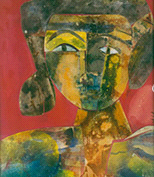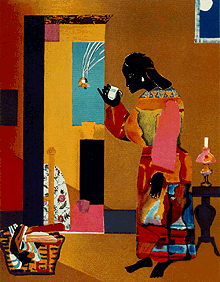Romare Bearden Lesson
Romare Bearden: 1912-1988
Early Years

Born in Charlotte, North Carolina, in 1912, Romare Bearden settled with his family in the Harlem neighborhood of New York City in 1915. His father worked as an inspector for the city sanitation department and his mother was a prominent Harlem figure: chairman of her school board, national treasurer for the Council of Negro Women, and community activist.As a young boy, Bearden made occasional trips to visit his grandparents in the South and his maternal grandmother in Pittsburgh, where he spent his fourth-grade year of school in 1920 and finished his last two years of high school, from 1927 to 1929. It was in the neighborhood in which his grandmother lived that he met his childhood friend Eugene, whom Bearden credited with teaching him to draw.Bearden attended New York University and studied mathematics, but art continued to interest him and he began to paint in 1935. At the Art Students League in New York he studied with the German artist George Grosz, who encouraged him to incorporate social and political commentary in his art. Between 1935 and 1937 Bearden earned money as a professional artist by drawing political cartoons for the Baltimore Afro-American.
Beginning to Paint
Bearden started painting later than many other artists of his generation, and his latent talents took longer to develop than some of his contemporaries. The middle years of his life chart a constant struggle to find his artistic vision. After serving in the military during World War II, Bearden returned to New York to present three solo exhibitions between 1945 and 1947 at the Samuel Kootz Gallery.
This initial public success was followed by a three-year period of intense study of Old Master paintings, during which time Bearden tried to understand the basic structural elements of acclaimed works of art. Because he did not like to draw under observation in museums, he enlarged black-and-white photographs of Old Master works to copy in the privacy of his home. The photographs encouraged him to apply color spontaneously without considering the original color palettes. This free and vibrant use of color would later influence his collages.
Bearden Searches for his Style
The GI Bill of Rights (1944) allowed Bearden to study philosophy at the Sorbonne in Paris for six months in 1950. Bearden familiarized himself with French art and pondered the direction of his own work. He returned to America convinced that the French art scene was moribund and that the art world was now centered in New York.
Painting continued to occupy his attention, yet Bearden had trouble finding an appropriate style and subject matter for his art when he returned to the United States.
Music always occupied an important place in Bearden's life. He grew up listening to jazz and the blues, and was acquainted with many musicians, including Duke Ellington. During a crisis precipitated by his inability to paint in 1951-52, Bearden turned away from the visual arts and took up music as a career. He founded the Bluebird Music Company with the composer Dave Ellis and went on to have twenty of his own songs recorded. His success as a songwriter did not, however, fulfill all of Bearden's creative energies.
In 1952 he accepted a job with the Department of Social Services, working as a liaison between immigrant Gypsies and the community, and in 1954 he married Nanette Rohan who gave him the emotional support he needed in order to begin painting again. Bearden continued with his nine-to-five job and painted in his spare time. After fourteen years of social work, Bearden finally began to make enough money from the sale of his paintings and collages to support himself through his art.
The Collages and Widespread Success

Bearden achieved success in 1964 when he set aside abstract oil painting and began to work in collage. A 1971 retrospective at the Museum of Modern Art gave him widespread recognition as an important contemporary artist. He was elected to the National Institute of Arts and Letters in 1972 and worked productively through the next two decades until his death in 1988.
Bearden was an artist, educator, author, theorist, and a benefactor who helped young African American artists establish their careers. In 1969 he founded the Cinque Gallery with Norman Lewis and Ernest Crichlow to provide a space for young minority painters and curators to display their work and gain experience in the art world. Bearden also addressed the need to document the unwritten and often forgotten history of African American artists. With the help of Caroll Greene, Bearden organized the 1967 exhibition "The Evolution of Afro-American Artists: 1800-1950" at the City College of New York. One hundred and fifty works by fifty-five black artists were presented in the first exhibition to offer a retrospective of African American work."
Bearden Assignment
Answer this questionnaire about Romare Bearden and his art:
(All written work should be typed in an ordinary font, size 10 or 12, and double-spaced.)
- What does “collage” mean?
- When was Bearden's most productive period?
- Who are some of the main users of collage technique?
- What are the different techniques that Bearden used to make art in addition to collage?
- How did Bearden's recognition develop?
- What did peole write about him?
- What events or phenomena helped Bearden become well-known?
- What was Bearden's main focus?
- Why isn’t collage considered as a pre-eminent style of art?
Write a paragraph about one work of Surrealistic visual art.
Remember that writing about art includes three types of writing:
- Description
- Interpretation
- Evaluation
Write a report about collage; write about …
• An artist; or
• An artwork; or
• The collage in twentieth century art; or
• The general history of collages.
• List your reference sources in a bibliography and or a "works cited" section.
Create a digital collage image in Photoshop or Fireworks or another image editing software title.
Use these guidelines:
• 6.25 ” x 10”
• 300 ppi
• CMYK
• White background
• Consider the use of the copy and paste functions as well as layers and transparency.
• Publish your image on the school intranet.
• Print your artwork on photo quality paper.
"The creative process, so far as we are able to follow it at all, consists in the unconscious activation of an archetypal image and elaborating and shaping the image into the finished work. By giving it shape, the artist translates it into the language of the present and so makes it possible for us to find our way back to the deepest springs of life." - Carl Jung
















